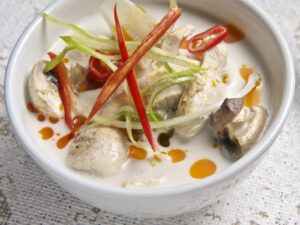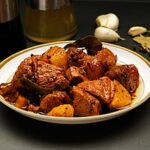
“Karahut”, worn on last day of a boy’s initiation and during war. Papua New Guinea, Maprik region, Abelam culture, 20th century. Musée des Arts Premiers, Quai Branly, Paris, photo Vassil, 4 March 2012, CCO 1.0 Universal license.
Recipes from Papua New Guinea
From the mettle-testing menu of the as-yet-only-dreamed-of Extreme Cuisine Restaurant, some of these recipes from a friend raised on an alligator farm in Papua New Guinea contain surprising ingredients. Sago grubs and fruit bats (flying fox) are considered comestibles within the ecology of the Pacific Island nations, but these recipes are adaptable to more readily available foodstuffs. Some species, python and certain fruit bats among them, are endangered and protected in many Pacific island locales, but are still hunted for ceremonial and magical purposes. Chicken is held to be a tasty substitute in these recipes from the 1950s and 60s.
Sago Grub Sate with Peanut Sauce
- 3 dozen Sago grubs
- 5 – 6 oz. ground fresh roasted peanuts or the same amount best quality peanut butter
- 4-6 small, hot chiles, finely chopped
- 1 clove garlic, finely chopped
- 1 stem lemon grass, crushed
- 1 tbsp lime juice
- 2 tbsp soy sauce
- 200 ml coconut milk
Steam Sago grubs until just cooked. You may remove the heads, but it is not necessary. Combine the hot chiles, finely chopped garlic, peanuts, crushed lemon grass, lime juice, soy sauce, coconut milk, and heat, but do not boil, to make Sate Sauce.
Put the grubs on a wooden skewer (six to a stick) and cover with half the sauce. Grill over a charcoal fire or in the oven for about 5 minutes. Then turn over, cover with the rest of the sauce and grill another 5 minutes. Serve with steamed rice.
The same Sate Sauce goes beautifully with a kids’ favorite, Chicken on a Stick: Take a couple of skinless, boned chicken breasts, slice them the long way, an inch wide. Marinate for 10 minutes to overnight in a mix of chopped garlic, finely chopped ginger, and soy sauce (some like to mix in a bit of barbecue sauce). Then poke a skewer through the chicken, and grill until just done, turning once. Douse with Sate Sauce and serve on rice as above.

Mount Hagen Cultural Show, Papua New Guinea, photo Yves Picq, 15 August 2009, CCA-SA 3.0 Unported license.
Flying Fox with Prunes and Cream Sauce
Megabats, large fruit bats, have been regularly consumed in Oceania, where on some islands, they are the only native land mammals. (Although certain bats were hunted as a food source in Vincenza, Liguria and Veneto provinces in Italy, almost to extinction, bats in Europe and the Americas were generally too small to have been commonly used for food.) While eaten primarily on special occasions today, there is evidence that they were an important food source for prehistoric hominids in Oceania as many as 70,000 years ago. They have also been key foods for Australian and Torres Strait First Peoples. Cave-dwelling bats are relatively easy to catch and kill because they congregate – a dozen or more may be taken in a hunting trip.
- 6 flying foxes (in case you are wondering, these are bats) You can substitute an equivalent weight in chickens.
- 1 1b. prunes
- 1 ¼ cup white wine
- salt, pepper
- 1/4 cup flour
- 2 oz. butter
- 1 tbsp red currant jelly
- 1 cup thick cream
Remove the flesh from the flying foxes. Either plunge the animals in boiling water for a while, then behead and skin them and remove the flesh from the bones or roast the animals for a little over an open fire, remove, and when cool, break open down the backbone and remove the flesh from the skin.
Soak the prunes overnight in 1 cup of the wine, then heat for about ten minutes in the wine before using. Season the flying fox meat with salt and pepper and roll in flour. Sauté in butter over a low heat until brown. Add the rest of the wine, cover and cook another 20 minutes. Add the juice /winefrom the prunes and transfer the prunes onto a serving dish. Cook the meat in the prune juice, uncovered, for another 10 minutes, then place on the serving dish with the prunes.
Paia Banana – Bananas on Fire
- ripe bananas
- butter
- brown sugar
- coriander
- brandy
- cream
Heat butter in a pan. Peel and slice bananas lengthwise and place in the pan. Cover with brown sugar and coriander. Cook on medium heat, turning once. Warm the brandy in a separate pan, pour over the bananas and ignite. Serve with ice cream, cream or both. Cover with sauce.

Kundu Drum, rosewood, Papua New Guinea, Brucke Museum, Berlin, photo Nick Ash, Berlin, CCO 1.0 Universal license.
Paua Sup (Power Soup)
Warning: Do not cook; for information only! The preparation of the following traditional recipe requires an ingredient which is now a protected species at high risk. This recipe is given as collected.
First, catch your snake. This should be a python. Tie the snake to a pole and while still alive, skin and remove excess fat. Remove the gall bladder and keep for other culinary/medical purposes. Chop the snake into one inch lengths and place in a pot of cold water. Bring to the boil and simmer for 3-4 hours. When cooking is complete, discard the water. (Boil the head of the snake separately, the liquid is useful as a remedy against choking.) Meanwhile, prepare separately stock from a chicken (an old one) and/or pork scraps, onion, chili, salt and pepper. While this is cooking, skim off the fat and discard. Cook for 3-4 hours, let cool and remove all extraneous elements. Prepare also a herb soup of abika cabbage and a large quantity of ginger. Combine all ingredients and reheat. As an optional extra, brandy may be added.
And a Just Plain Delicious East-Asia Holiday Medley…
Our friends tend to spend a good part of their lives in faraway places. These friends bring us recipes – many of which have become holiday favorites. Here is a sampling of easy-to-make and adaptable dishes.
Thailand via Santa Fe – Tom Kha Soup

Tom kha kai, photo by Thor, 25 Feb 2010, CCA 2.0 Generic license.
This soup takes about half an hour to chop ingredients and less than ten minutes to cook. Add less coconut milk and liquid stock to make the soup into an entree to be served on rice or clear noodles. Using fewer chiles makes the soup palatable for even very young children, who love the combination of fresh lime and sweet coconut. Warning! Do not add the fish sauce to a dry pan – add other liquids first.
- 3 Tbsp. finely chopped fresh ginger
- 5 to 10 finely chopped garlic cloves
- scant handful fresh basil
- 2 cups sliced mushrooms
- 1 whole Kaffir lime leaf (optional)
- 1 stalk lemon grass, cut into 3-inch lengths and crushed
- 1 to 3 finely chopped jalapeno or other fresh chiles or 6-8 dried Thai red chiles
- 3-inch section crushed fresh galanga (if you can find it)
- 2 to 4 cups chicken stock (vegetable stock for a vegetarian version)
- 1/8 cup fish sauce (from pressed anchovies, nam pla in Thai)
- 1 1/2 lb. boned, skinned chicken breasts, cut into 1 inch cubes (eliminate for vegetarian version)
- 2 to 3 cups coconut milk
- 1/4 cup fresh lime juice
- fat handful chopped fresh cilantro
Toss for a few seconds in a heated, lightly oiled, seasoned heavy saucepan, the garlic, ginger, jalapenos, mushrooms, Kaffir lime leaf, fresh basil, galanga and lemon grass. Add the stock, then the chicken pieces and cook until chicken is done. Add cubed tofu. Add the coconut milk. From this point simmer gently, do not boil or coconut milk may curdle. Add the lime juice, fish sauce, cilantro and basil, and serve!

Above: Pork Adobong Baboy, photo Joy D. Ganaden, 21 May 2022, CCA-SA 4.0 Int’l. license, and Below, Chicken Adobo, photo Jack Lawrence, 30 June 2015, CCA 2.0 Generic license.
The Philippines – Adobo – A Peasant Dish Fit for a King
- 3 1/2 pounds chicken breasts
- 3 pounds boneless pork
- 5 whole black peppers
- 2 bay leaves
- 1/4 cup olive oil
- 1/2 cup beef broth
- 1/4 cup (at least) minced garlic
- 1/2 cup red wine vinegar
- 1 Tbsp. salt
- 1 cup coconut milk
- 1 tsp. coarse pepper

Chop chicken into two-inch pieces. Cut pork into one-inch pieces. Brown meat in small amounts in hot oil. Add everything except coconut milk and cook over low heat until the meat is done through. Add coconut milk and cook 10 minutes longer. Serve over rice. Makes twelve servings.
Thailand – Gai Pat King – Ginger Chicken (This dish is also delicious made with scallops or beef).
- A generous handful of dried black fungus – If it looks edible, you have the wrong stuff.
- 2 tbsp. vegetable oil
- 3 cloves garlic
- 1 tsp. bean sauce
- 2 – 3 tbsp. fresh ginger – finely chopped
- 4-6 boned, skinned chicken breasts, excess fat removed, and cut into bite sized pieces
- 1/2 medium yellow onion –
- quartered white pepper
- 2 tbsp. oyster sauce
- 1 tsp. sugar and 1/4 tsp. salt dissolved in 1 tsp. white vinegar
- 2 green onions – sliced on diagonal into 2-inch lengths
- 1 tbsp. chicken stock or water
Soak weird looking black fungus in water until mostly soft, about 20 minutes. Drain, then cut out any really tough sections and set the rest aside. Heat oil in large pan or wok. Add garlic, bean sauce and ginger. Sauté a minute, then add chicken (or scallops or beef), soft fungus, yellow onion, pepper, oyster sauce, vinegar mix, green onions and chicken stock. Cook just until chicken is done. Serve hot over white rice.

Selling mango sticky rice at Huamum Market, photo Pauloleong2002, 15 December 2023, CCA-SA 4.0 Int’l. license.
Thailand – Sticky Rice with Mangoes
- 1 1/2 cups water
- 1 cup Thai white rice – soaked 1 hour and drained
- 2 tbsp. and 1/4 cup sugar
- 2/3 cup coconut milk
- 1/4 tsp. vanilla extract
- pinch salt
- 1 tbsp. cornstarch mixed in 1/3 cup water
- 2 large mangoes, peeled and cut in long slices
- 2 tbsp. toasted sesame seeds
Bring water to boil, add soaked rice and 2 tbsp. sugar, reduce heat to very low, cover and cook about 10 minutes. Remove pan and let sit 20 minutes. Combine coconut milk, vanilla, salt and 1/4 cup sugar in small saucepan and bring to a boil. Drizzle in cornstarch mixture until just thick. Set aside. Mound rice on small plates, surround with mango slices and drip on coconut milk sauce. Top with sesame seeds.
Thailand – Khao Pad – Rice served in Pineapple
- 1 1/2 cups cooked basmati or Thai rice
- 1 fresh pineapple, halved and scooped out
- 5 tbsp vegetable oil
- 3 lightly beaten eggs
- 3/4 cups raw shrimps
- 1/2 large onion, chopped
- 1 fresh red chili, chopped
- 2 tbsp fish sauce
- 2 tsp finely chopped fresh ginger
- handful fresh cilantro

Pineapple fried rice, served in a hollowed out pineapple, photo Grendelkhan, 22 June 2018, CCA-SA 4.0 Int’l. license.
Chop pineapple flesh and allow to drain. Heat oil and pour egg into saucepan to make a thin omelet. Remove and slice into strips. Add more oil and fry onion, then add shrimp, ginger, fish sauce, rice, pineapple and chili and stir rapidly over high heat for 2 minutes. Ladle into hollowed out pineapple, and garnish with cilantro and omelet strips.
 Matua mask from Papua-New Guinea, photo Wolfgang Sauber, CCA-SA 4.0 license.
9 July 2022, Berlin Ethnological Museum.
Matua mask from Papua-New Guinea, photo Wolfgang Sauber, CCA-SA 4.0 license.
9 July 2022, Berlin Ethnological Museum. 

